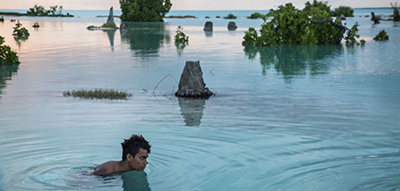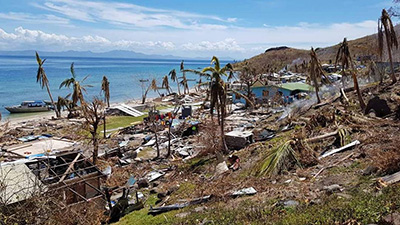Ocean Newsletter
No.512 December 5, 2021
-
Japan Maritime Self-Defense Force Officer Candidate School’s Training and Contributions to the Community
YAGI Koji
Superintendent, Japan Maritime Self-Defense Force Officer Candidate School / Rear AdmiralThe mission of the Japan Maritime Self-Defense Force Officer Candidate School is to provide students the basic knowledge and technical skills necessary for entry-level officers, offering education that focuses on fostering seamanship and leadership. At Etajima, which Maritime Self-Defense Force officers consider their “home away from home,” all officers acquire specialized knowledge and capacities necessary for seamen, as well as an international outlook, language skills, and flexibility for coping with the ever-changing ocean. -
Climate Security Issues in the Pacific Islands: Between Crisis and Resilience
Fabrizio BOZZATO
Research Fellow, Ocean Policy Research Institute, The Sasakawa Peace FoundationClimate change risk arising in the Pacific Islands is taking diverse and pernicious forms. Ocean temperatures, changing frequencies of tropical cyclones, and rising sea levels affect marine and terrestrial ecosystems as well as local communities, livelihoods, and cultures. Climate-fragility risks are also on the rise, from forced migration to economic activities to the disappearance of maritime boundary basepoints. Without the support of development and climate security partners, Pacific Island nations cannot adapt to climate change while maintaining minimal disruption. -
Collaboration between Community, Science, and Art for “Transformative Change”: The Front Lines of Coral Reef Sustainability Research
SUGIMOTO Aoi
Researcher, Social-Ecological Systems Department, Fisheries Research Institute, Japan Fisheries Research and Education Agency“Science Communication” - a concept linking science and society that encourages positive social change on a scientific basis - is gathering attention as a new approach for changing minds and behaviors in order to create a sustainable future. I would like to introduce an example of a collaboration between community and science in which artists and designers undertake a project related to conservation of the coral reef ecosystems of Ishigaki Island in Okinawa Prefecture.
Climate Security Issues in the Pacific Islands: Between crisis and resilience
[KEYWORDS] climate risk / natural disasters / state fragilityFabrizio BOZZATO
Research Fellow, Ocean Policy Research Institute, The Sasakawa Peace Foundation
Climate Security Issues in the Pacific Islands Region
The Pacific Islands Region comprises the island states and territories, excluding Australia (and New Zealand), distributed over an area of 70 million km2 of ocean between East and Southeast Asia and the Americas. It is conventionally subdivided into the ethno-geographic ternion of Melanesia, Micronesia, and Polynesia. Pacific Island polities are very diverse in terms of territory, population, developmental and political dynamics, economic resilience and governance capabilities. Yet, Pacific Islanders are acutely aware that their countries and societies - their very land and ocean - are all vulnerable to the effects of climate change. Accordingly, in the 2018 Boe Declaration, the leaders of Pacific Island Forum nations conveyed that climate change is the “single greatest threat” to the security of their region and concurred on an expanded concept of security putting climate change center-stage, alongside traditional security issues.
The climate change risk arising in the Pacific Islands is taking diverse pernicious forms: rising ocean temperatures, shifting rainfall patterns, changing frequencies and intensities of storms and drought, rising sea levels, and changing ocean chemistry affect marine and terrestrial ecosystems, as well as local communities, livelihoods, and cultures. Climate change is impacting on human health, infrastructure, coastal resources, disaster management, fresh water availability, agriculture, fisheries, forestry, marine ecosystems and tourism.
5 Climate-Fragility Risk Clusters
Drawing from the available literature - as well as from the examination of the Pacific Islands’ socio-economic situation, regional policies and political discourse - it is possible to identify five climate-fragility risk clusters for the region:
1)Climate displacement and migration
The combined action of climate change, environmental degradation and natural disasters cause displacement and forced migration, both internally and transnationally. Since land is a scarce commodity in the Pacific Islands, and is often customarily owned, the resettlements are likely to be resisted by local authorities and communities. This creates a risk of social tension and violence, especially if the resettlement is conducted without proper consultations with host communities. Apart from the unavailability of land for resettling, factors like ethnic and cultural differences between the migrating or receiving communities, or the strain the newcomers put on local resources and services can further complicate - or derail - the relocation process.
 A young man swims in the waters of the flood-damaged village of Abarao in Kiribati. The Pacific Islands are being severely affected by rising sea levels.
A young man swims in the waters of the flood-damaged village of Abarao in Kiribati. The Pacific Islands are being severely affected by rising sea levels.
https://news.un.org/en/story/2019/05/1039431
2)Impacts on ocean economy (fisheries, tourism)
The economies of many Pacific polities are heavily dependent on the revenues generated by fisheries and tourism, often referred to as the ‘ocean economy’. Climate change threatens to adversely affect both industries. Notably, the Western and Central Pacific Ocean contains more than half the global tuna stocks, on which several Pacific SIDS are critically dependent on. Global warming is undermining this important source of revenue and employment because, as temperatures increase, marine species such as tuna are gradually moving away to seek colder waters. According to the projections on regional tuna stocks redistribution, by 2050 the reduction of tuna biomass in the island states’ Exclusive Economic Zones could result in overall government revenue losses of up to 15 percent yearly for eight of them. The projected figures on tuna migration patterns - and the interrelated financial and occupational negativities - are causing great concern in the Pacific also because, on the one hand, they would unsettle the architecture of regional arrangements governing the tuna resources, and on the other hand lead to serious tension between the island nations and distant water-fishing states.
3)Impacts on health, food and water security
Climate impacts are increasingly undermining Pacific peoples’ health and quality of life, thereby impairing their ability to contribute productively to their economies and families. Healthcare systems in the region are under enormous stress and unable to cope. The aggravation of food and water security caused by climate change, combined with existing problems, would put at risk the livelihoods and health of Pacific Islanders, and bring about increased fragility with a potential for instability. Water security is another front of Pacific Island climate security. Many parts of Insular Pacific suffer from a lack of access to safe piped water and deficient water sanitation. In addition, climate change phenomena like inundation, salt water intrusion and droughts threaten fresh water supplies for low-lying atolls and small islands which recurrently declare states of emergency.
4)Natural disaster recurrence and coping capacity
The Pacific Islands are in one of the most natural disaster-prone regions in the world. Tropical cyclones are the most common form of natural calamity in Pacific Island countries, and the main cause of destruction and economic loss. Such cyclones can inflict hefty damage to infrastructure, such as roads and port facilities. Also, the agricultural sector can be hit tremendously hard, while reef fishing zones and forestry can be considerably impacted. For small island countries with a high dependence on agriculture and limited sector diversification, the economic repercussions are especially traumatic.
Global warming is increasing recurrence of cyclone, with shortening recovery periods in between, drives up the fragility risks and foils the island states’ development gains and potential. In fact, in response to post-disaster rehabilitation requirements, governments resort to a reallocation of budget expenditure and, in some cases, to cutting current expenditure in order to meet emergency and reconstruction needs. This normally involves drastic cuts in development budgeted expenditure.
 Global warming is leading to increasing frequency and intensity of tropical cyclones.
Global warming is leading to increasing frequency and intensity of tropical cyclones.
https://www.wwfpacific.org/?365655/Macuata-project-communitiesnot-spared-by-TC-Yasa
5)Impacts of sea-level rise on maritime zones and boundaries
Climate change, in the form of rising sea level and erosion, has profound implications for maritime boundaries in the Pacific islands. In the region, the coastal features that define maritime boundaries - low-elevation islands, atolls, sand bars, rocks, and reefs - often barely poke above the sea surface and are thus vulnerable to environmental changes. The submersion of many of those seemingly permanent markers would lead to the disappearance of critical maritime boundaries basepoints. Hence it is not only the region’s natural geography which is in danger, its political geography is at risk of being reshaped as well. Settling maritime boundaries is therefore a priority action to ensure that climate change does not grind at the jurisdiction of the Pacific Islands. On this account, at the August 2021 Pacific Island Forum virtual summit, the leaders of 18 Pacific Island countries and territories agreed to establish permanent maritime boundaries, notwithstanding climate-change related sea rise.
In Adapting to Climate Change Risk
In addition to the above five risks, there is also a risk brought by penetration of transnational organized crime and terrorism. Acting as a stressor on state capacities, climate change can thus aggravate the circumstances of small island states, even to the point of a breakdown in governance. In turn, serious state fragility may lead to the creation or consolidation of functional spaces in which organized crime and terrorist groups may penetrate, settle and thrive.
There is a tendency, to overplay the negative effects of climate change in the region, and to downplay its resilience.
Perhaps the most fundamental seedbed of environmental resilience in the region lies in its natural production systems. Large sectors of the ocean waters around Pacific Island coasts have been overexploited, but with appropriate management their sustainable productivity can be restored which attests to their innate resilience. The key to realizing these aspects of environmental resilience is informed and sustained management.
However, most pivots of resilience in the Pacific Islands directly involve its inhabitants. Another long-standing fount of resilience is the tradition of collective decision-making. Yet, despite the less-than-positive facets of external assistance, it is clear that Pacific Island nations cannot do without this is they are to adapt their people’s livelihoods to future climate change with minimal disruption. Ultimately, the fact that development and climate security partners continue to be willing to support Pacific Island nations in this way empowers them to face the brunt of climate change.
